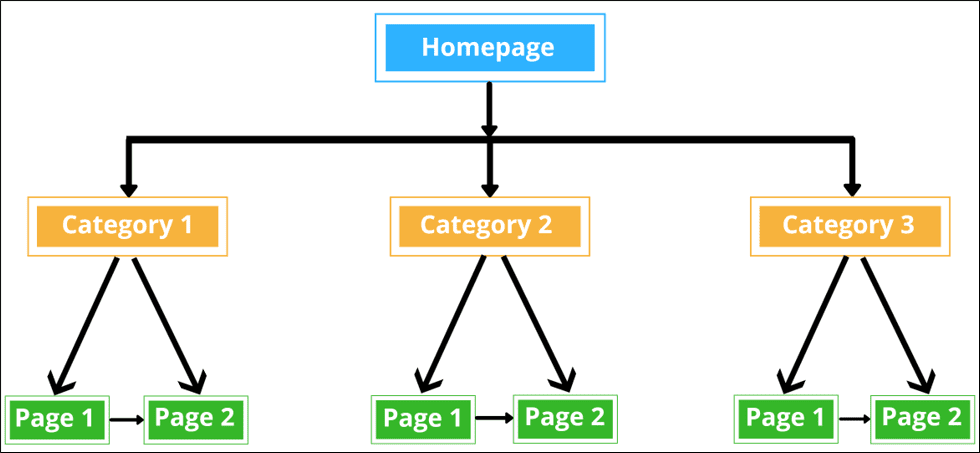The Importance of Link Structure for User Experience
Within the context of a website’s user experience (UX), link structure is an extremely important factor to consider. The accessibility of content, the ease with which search engines can crawl and index the pages, and the way in which people traverse a website are all impacted by this. Not only can a well-optimized link structure improve usability, but it also helps to the effectiveness of search engine optimization, which ultimately results in improved site ranks and increased user happiness. The significance of link structure, its influence on user experience, and the most effective methods for developing a robust internal linking framework are going to be discussed in depth in this article.
What is Link Structure?
Before gaining a grasp of its significance, it is necessary to define the structure of the links. In the context of a website, the term “link structure” refers to the manner in which links, both internal and external, are arranged and connected. Links that are internal to a domain refer to other pages within that domain, whereas links that are external to the domain direct users to other websites. The organization of these links and the reasoning that underpins them can have a considerable impact on both the behavior of users and the optimization of search engines.
Types of Links
When considering the structure of links, there are two primary categories of linkages to take into consideration:
Within the same domain, internal links are links that connect one page of your website to another page. These links are also known as navigation links. It is essential to have internal links in order to direct users and search engines across your website and ensure that they are able to locate content that is pertinent to their needs.
Links to external sources are links that are located on your website and go to other websites. The navigation of your website is not affected by external links in the same manner that it is by internal connections. This is because external links reference authoritative sources, which contributes to the trustworthiness of the information. https://diversewebsitedesign.com.au/doctor-website-design/
Why Link Structure Matters for User Experience

For a great user experience to be created, it is essential to have a link structure that is both user-friendly and well-organized. In order for visitors to navigate your website with ease, they rely on links that are both obvious and logical. It is possible for consumers to become dissatisfied if the link structure is unclear or broken, which can result in high bounce rates and low engagement.
1. Enhances Website Navigation
The ability to facilitate navigation is one of the most important things that a well-designed link structure can do. Users will have an easier time finding information that is relevant to them if you carefully place internal links within your content and menus. This eliminates the need for them to search or browse through numerous layers. A straightforward and user-friendly linking structure ensures that users are able to navigate unhindered from one page to the next.
If a user is reading an article about web design, for instance, an internal link to a related piece on user interface and user experience design can enhance their trip by offering additional value when they are reading the article. The bounce rate is decreased as a result of this, which not only increases engagement but also keeps users on the site for longer.
2. Increases Content Discoverability
Your material will also be easier to identify if it has a well-defined relationship structure. Through the usage of internal links, visitors and search engines are able to discover key pages on your website that may not be directly accessible through the primary navigation bar. It is possible for people to explore further into issues that interest them by connecting content that is important to them.
In addition, you can ensure that essential pieces of information continue to be highly visible to your audience by linking cornerstone or evergreen content across numerous sites. This will result in an increase in the number of page views and user interaction.
3. Improves Usability for All Users
The usability of a website is improved for all sorts of users, including those who have accessibility requirements, when the link structure is adequately developed. Anchor text that is appropriately identified and descriptive might be of assistance to users who are utilizing screen readers or other assistive technology in finding their way around the website. Users are able to comprehend where a link will take them without having to make an educated estimate on their own when the text of the link contains useful context.
For instance, rather to utilizing a nonspecific “Click here,” adding anchor text such as “Read more about our SEO services” provides greater direction on the content of the destination page, which increases accessibility and user confidence.
The Relationship Between Link Structure and SEO
Although the user experience is the major focus of link structure, it also plays a vital part in search engine optimization (SEO). Your website’s internal links are what search engines like Google use to scan and index your website, which helps them determine the significance and relevancy of the information on your website.
1. Assists Search Engine Crawling
Links allow search engines to traverse through webpages and gain an understanding of the structure of those websites. The efficient discovery of all of your website’s pages by search engines is facilitated by an internal linking system that is well-organized. It is possible that certain sites will stay “orphaned” if correct internal linking is not implemented. This means that they will not be easily available to users or search engines, which significantly reduces their exposure in search results.
You can increase the likelihood that certain pages will be indexed and ranked by search engines by carefully linking those pages, particularly from pages with a high level of authority to pages that are more recent or receive fewer visitors.
2. Passes Link Equity
The flow of link equity, also known as the value that is transferred from one website to another in terms of search engine optimization, is also influenced by the structure of your links. The link equity of a website is increased when it receives external backlinks from domains with a high level of authority. You are able to distribute that value by linking these high-authority pages to other internal pages, which in turn improves the search engine optimization performance of pages that are less well-established.
Adding internal links from the homepage to crucial service pages, for instance, can help raise the ranking of those linked pages. This is especially true if your site is already receiving a large number of backlinks of a good quality.
3. Improves Keyword Optimization
Another technique to improve user experience and search engine optimization is to optimize your internal links with anchor text that is rich in keywords. By incorporating pertinent keywords into your anchor text, you not only assist consumers in comprehending the content of the page that is linked to, but you also communicate to search engines the keywords that the page need to rank for.

On the other hand, it is of the utmost importance to prevent over-optimization, as Google penalizes websites that attempt to manipulate results by using an excessive amount of unnecessary keywords. Instead, you should concentrate on anchor text that is natural, descriptive, and which increases usability.
Best Practices for Creating an Effective Link Structure
It is necessary to engage in strategic planning and to prioritize the user experience when developing an efficient link structure. Consider some of the following examples of best practices:
1. Use a Logical Hierarchy
You should make sure that the linking structure of your website adheres to a logical hierarchy whenever possible. It is essential that the most significant pages, such as the homepage, service pages, or product categories, are easily accessible from the primary navigation. When visitors navigate to these high-level sites, they should be able to easily navigate to content that is more particular or connected to them through the usage of internal links.
On the homepage of a website that focuses on digital marketing, for instance, there should be connections to more general themes such as search engine optimization (SEO), pay-per-click (PPC), and social media marketing. There is the potential for each of these parts to lead to other guides or case studies that are more in-depth.
2. Limit the Number of Links per Page
While internal links are necessary for navigation and search engine optimization, overloading a page with an excessive number of links can cause users to feel overwhelmed and can also degrade link equity. It is important to ensure that each page has only the links that are the most pertinent and helpful. This is a basic rule of thumb that states that each page should not have more than one hundred links, which should include both internal and external connections.
3. Regularly Audit Your Links
User experience and search engine optimization can both be badly impacted by broken links and obsolete material. You should perform regular audits of the link structure of your website in order to discover any broken or irrelevant links and then replace them with information that is both functional and up to date. There is a wide variety of software, such as Google Search Console, that can assist you in determining whether or not your website has any link problems.
4. Optimize Anchor Text
An anchor text is the text that can be clicked on within a hyperlink. Anchor text should be descriptive, keyword-rich, and that appropriately reflects the content of the page that is being linked to. Stay away from terms that are too general, such as “click here,” and instead concentrate on words and phrases that are contextually relevant and give value to both users and search engines.
Conclusion
It is impossible to exaggerate the significance of link structure with regard to the user experience. Enhancing navigation, increasing the discoverability of material, and improving accessibility for all users are all benefits that come from having an internal linking structure that is well established. In addition, a strong link structure helps search engines crawl the website, improves search engine optimization effectiveness, and contributes to the distribution of link equity throughout the website.

You are able to maximize both the user experience and the search engine optimization value of your website by doing things like applying best practices such as a logical hierarchy, strategically placing links, and doing regular link audits. When the structure of your links is treated with careful consideration, it results in the creation of a smooth user experience that improves user satisfaction, engagement, and the overall success of your website.





